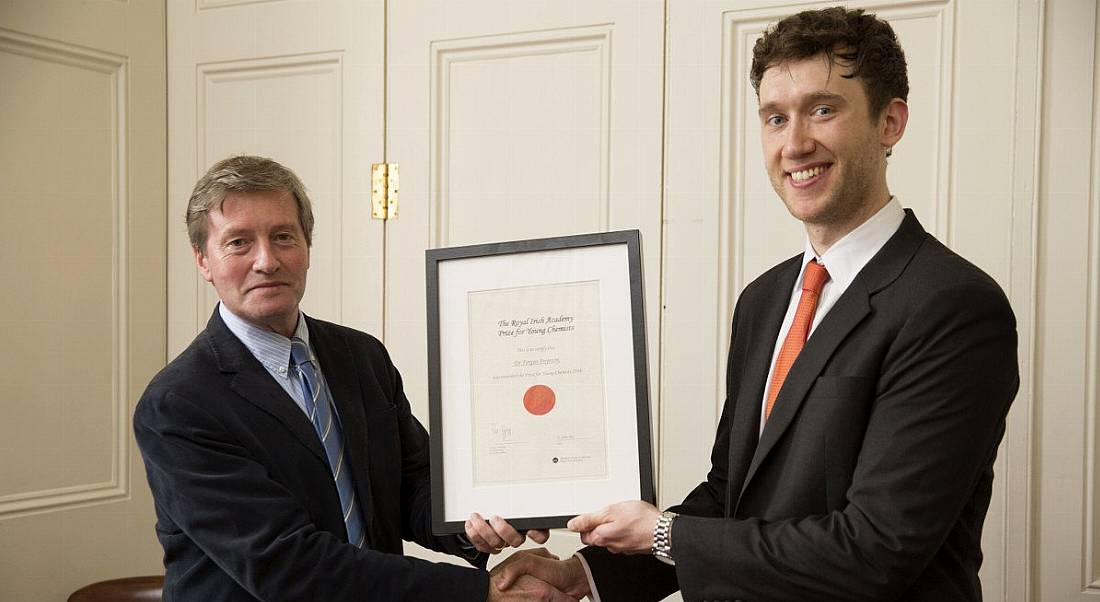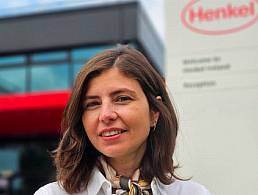Award-winning chemistry researcher Dr Fergus Poynton explains how the light-activated therapeutics he is working on can aid in cancer detection.
Dr Fergus Poynton has enjoyed a successful summer.
In June, he was awarded the annual Royal Irish Academy (RIA) prize for the most outstanding Irish PhD thesis in the general area of the chemical sciences. As the RIA’s selected winner, Poynton was then nominated to go forward for the prestigious International Union of Pure and Applied Chemistry-Solvay (IUPAC) International Award for Young Chemists.
Once again, Poynton proved a winner – one of just five from around the world. This outstanding achievement was marked with a ceremony at the RIA, followed by a trip to Brazil to collect his prize at the IUPAC General Assembly.
Now graduated from a chemistry PhD student to a postdoctoral researcher with the Gunnlaugsson and Kelly research groups in the School of Chemistry in Trinity College Dublin, Poynton took time out amid his prize-winning whirlwind to tell us about his current research involving light-activated therapeutics.
What led you to the role you have now?
At school, science was my favourite subject and, therefore, I studied natural sciences at Trinity College Dublin. During my undergraduate degree, I was very interested in how molecules could be designed to carry out specific functions, such as to relieve pain in the case of analgesic drugs, and, therefore, I chose to specialise in chemistry for my degree.
From this, I chose to undertake my PhD in chemistry, under the supervision of Prof Thorfinnur Gunnlaugsson and Prof John Kelly in the School of Chemistry at Trinity College and was awarded an Irish Research Council Government of Ireland Postgraduate Scholarship to do so.
Tell us about your research.
Just as plants can use the energy from sunlight to produce fuel for growth, I make compounds that can use the energy from light to power them to either produce light of their own, which we can then detect; or react with and damage biomolecules, such as DNA. This gives them potential for use as diagnostic agents or light-activatable therapeutics.
With regards to diagnostic applications, we are interested in making compounds to detect DNA. These compounds produce no light in the absence of their DNA target. However, in the presence of DNA, they produce bright light, which we can then detect to signal the presence of the target DNA.
To illustrate this concept, if you imagine being in a large stadium full of people and you are asked to spot a single person holding a lit candle, it is very challenging. However, if you now imagine that it is night-time and the stadium is in total darkness and you are asked to spot the one person holding a lit candle, the task becomes considerably easier. This is why diagnostics, which look for the light produced by a compound that is only ‘turned on’ in the presence of their target, can detect extremely low quantities of a substance, which could be very important for detecting the early stages of a disease, where there may only be small amounts of the disease marker present in patient samples.
In the case of developing light-activatable therapeutics, we make compounds that, instead of using the energy from the light we shine on them to produce their own light, they actually use this energy to react with and damage specific molecules around them. For example, when our compounds are in the presence of DNA and are kept in the dark, no damage occurs to the DNA. However, when exposed to light, the compounds react with and damage the DNA, which could have potential as an anti-cancer treatment, as DNA is essential for cells to replicate and survive. When these compounds are administered to cancer cells, we have found that they have little effect on the cells when they are kept in the dark. However, when the cells are then exposed to light, the compounds are activated, which leads to the death of the cancer cells, and therefore could result in the destruction of tumours in the body.
One of our main aims has been to understand what happens within these compounds after they take in energy from light and then either produce light of their own, or react with and damage other molecules in their surroundings. However, these processes occur incredibly fast (within less than one-millionth of a second). Using high-speed lasers, we have been able to watch these processes as they occur and assess what factors have an important impact on them. The goal is that, by understanding these processes in detail, we can then optimise and design new compounds with better features for use both as diagnostics and light-activated therapeutics.
What first stirred your interest in this area?
I have always had a keen interest in the various ways that light can be used in medicine, whether it’s for laser eye surgery, detecting disease markers or treating various diseases, such as psoriasis.
When I was in college, my grandmother developed skin cancer and it was very hard to see the negative effects of the treatments that were being used to try to fight the disease. I then began researching the treatments for cancers, such as radiotherapy, chemotherapy and surgery, and I came across a cancer treatment using light, called photodynamic therapy.
This therapy involves giving a patient an inactive drug, which disperses throughout the body. The drug can be activated with light to become toxic to cells and, therefore, by shining light on the area of the body affected by a particular cancer, the tumour can be shrunk or destroyed. This also means that areas in the body that are not exposed to light do not suffer any damage and, therefore, many of the side effects seen with traditional chemotherapy drugs can be avoided.
In cancer therapy, it’s really important to catch the disease at the earliest possible stage and treat it effectively and this is why I decided to undertake research into diagnostic and light-activatable therapeutics.
Describe a typical day in your research life.
I don’t really have a typical day, it varies quite a bit depending on the stage of a project that I am working on. Some days I would spend in a chemistry lab making compounds and other days, I would be examining how these compounds interact with DNA or working with our biochemistry collaborators to test them in living cells. Other times of the year, I would be over at the Rutherford Appleton Laboratories in the UK with our collaborators, using high-speed lasers to investigate the underlying processes within these compounds when they are in the presence of DNA or in cells.
Which skills and tools do you use on a daily basis?
The skills and tools I use on a day-to-day basis vary as much as my activities from day to day. These would range from the synthetic and analytical skills required for making and assessing new compounds, and using various software packages for processing the data that I collect during experiments.
I regularly use a number of scientific databases for reviewing the scientific literature to aid in my data interpretation and keeping up to date with new scientific findings in my field.
Communication and presentation skills are very important, as I am very often writing progress reports on my projects and presenting them to my research group and collaborators.
Because my work has links into various research fields, I am always studying and learning about new techniques and fields of research. And, while I’m not sure that it’s technically a skill, I’ve become very accustomed to asking people in various research fields for help and guidance when I’m stuck, and I am always blown away by how eager they are to help and explain concepts that I am having difficulty with. A professor once told me that if you want to expand your research and link in with a new field, all you need is a textbook and a good collaborator who can guide you.
What applications do you foresee for your research?
In addition to these compounds being able to act as diagnostic agents to detect the presence of DNA, they can also be used to obtain various information on parameters, such as the structure and sequence of DNA for basic research purposes. Moreover, they can be used to visualise the DNA within live cells for research in cellular biology. Recently, researchers have been using these, and similar compounds, to develop diagnostics for neurodegenerative diseases such as Alzheimer’s disease.
With regards to their therapeutic applications, we have seen that these compounds have great potential as light-activated anti-cancer agents. Therefore, I believe these compounds have a promising future for medical development. In fact, a Canadian company, Theralase Technologies, is working with a similar compound to our own, and is ready to begin clinical trials for its use in light-activated therapy for bladder cancer in Canada. So, excitingly, it’s already starting to become a reality.
Are there any common misconceptions about this area of research?
While not a misconception, I have found that most people I speak with have never heard of the concept of treating cancer with light-activatable therapeutics, even when I discuss this concept with scientists working in biomedical research. In contrast, the concept of developing new diagnostics is widely known, particularly as more medical diagnostics, such as blood sugar monitors, become commercially available and allow people to monitor their own health.
I do not know the reason for this lack of awareness with regards to the treatment of cancer with light-activatable therapeutics. However, I do not believe that it is lack of interest. In my experience, members of the public have been extremely interested and enthusiastic when I have spoken to them about this therapeutic approach during public outreach events organised within Trinity College. Therefore, I would be very interested to hear people’s views on the matter.
When you first started work as a researcher, what were you most surprised to learn was important in the role?
Patience.
While scientific discoveries and innovation are progressing at an incredible rate, on an individual level it can feel like quite the opposite. Because we are looking at things that have yet to be studied and well characterised, there is a huge amount of trial and error, repetitions and setbacks.
As a colleague of mine once told me, there’s a reason why they call it ‘re-search’. But that is part of the challenge and makes it extremely rewarding when you do finally manage to crack a problem or discover something new.
What do you enjoy most about your career in research?
Having the opportunity to research and address an unmet need in society, which will benefit other scientists and hopefully aid in the development of new diagnostics and disease treatments is a huge source of motivation for me and brings me a lot of satisfaction in my research.
As well as this, I really enjoy how interdisciplinary scientific research is becoming. Through my research, I get to work closely with collaborators in various areas of chemistry, as well as researchers with backgrounds in biology and physics. It’s amazing how different the perspectives of people can be between different research areas and I’ve found it a fantastic forum for troubleshooting problems that arise during our research and coming up with new ideas and hypotheses.




